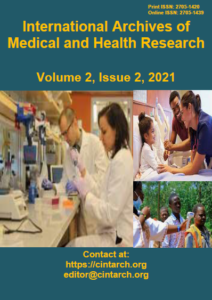
International Archives of Medical and Health Research (IAMHR), pISSN: 2705-1420; eISSN: 2705-1439
October to December 2021 Vol 2(2): pp.1-9 DOI: https://doi.org/10.33515/iamhr/2021.012/04
Copyright © 2021 C-International Archives
Original Article
Comparative assessment of motor function in children with spastic cerebral palsy subjected to two modalities of physiotherapy
Joy F. Legbo1*, Hamidu Ahmed1, Murtala M. Ahmad1, Kehinde J. Awosan2, Jessica T. Ango2
1Department of Paediatrics, Usmanu Danfodiyo University Teaching Hospital, Sokoto, Nigeria
2Department of Community Medicine, Usmanu Danfodiyo University Teaching Hospital, Sokoto, Nigeria
*Corresponding Author’s Email: adamajoy94@gmail.com
Published December 30, 2021
ABSTRACT
Background: Cerebral palsy (CP) is one of the most common disorders in patients presenting to Paediatric Neurology Clinics in Nigeria with most of them being spastic CP cases. Aim: This study aimed to do a comparative assessment of motor function in children with spastic cerebral palsy subjected to two modalities of physiotherapy. Materials and Methods: This was a two-group randomized-subjects pretest-posttest study among 170 children with spastic cerebral palsy attending the Paediatric Neurology Clinic of Usmanu Danfodio University Teaching Hospital (UDUTH), Sokoto, Nigeria. They were selected by universal sampling and randomized into continuous and intermittent physiotherapy treatment groups. Assessment of spasticity and motor function was done in the respective groups at baseline (together with questionnaire administration), and after 12 weeks and 24 weeks of treatment using the MAS and the GMFM-88 scales. Results: Spasticity reduced steadily in the two treatment groups at 3 and 6 months of therapy, and the proportion of participants with severe spasticity reduced significantly from 36.5% and 40.0% at baseline in the continuous and intermittent groups respectively to 5.9% at 6 months of treatment in both groups. Also, there was a steady increase in motor function at 3 months and 6 months with a significant increase in motor function at 6 months as compared to baseline in both groups. There was no significant difference (p > 0.05) between the two treatment groups with regard to reduction in spasticity and improvement in motor function. Conclusion: This study shows that there is no significant difference between continuous and intermittent physiotherapy in terms of reduction in spasticity and improvement in motor function. This gives healthcare providers the option of tailoring the choice of therapy to what is more convenient for the patients and their caregivers.
Keywords: Motor function, spastic cerebral palsy, physiotherapy, children

